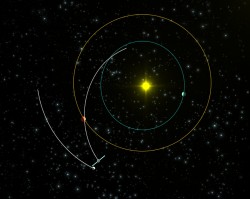[/caption]
Time critical is approaching for the Rosetta spacecraft and it’s flyby of the asteroid 2867 Steins. Closest approach is expected on September 5, at 20:58 CEST, (Central European Summer Time), 2:58 pm EDT (US Eastern Daylight Time). To help the public follow the flyby, the Rosetta team now has a blog available, and a timeline has also been posted. At the time of closest approach, Rosetta is planned to be 800 km from the asteroid, passing by at a speed of 8.6 km/s relative to Steins. Both Rosetta and Steins will be illuminated by the Sun, providing an excellent opportunity for science observations.
Although most scientific observations will take place in the few hours around closest approach, several instruments will be switched on for a longer time around the event.
Between 40 and 20 minutes before closest approach, Rosetta will be flipped and the spacecraft will switch to a specially designed asteroid fly-by mode, an optimal configuration that supports the intensive observation and tracking activity of the on-board instruments. The first images and results will be available for presentation to the media during a press conference on Saturday, September 6 at 12:00 CEST.

The timeline is as follows (more details are available in the Rosetta Blog — all times CEST (Central European Summer Time):
1 September
02:20 Instruments switched on (except OSIRIS which was already on for the navigation campaign)
4 September
07:20-11:20 Slot for possible trajectory correction manoeuvre (36 hours before closest approach)
13:20-18:20 Last opportunity to acquire images for optical navigation campaign
5 September
07:20-10:20 Slot for possible trajectory correction manoeuvre (12 hours before closest approach)
10:20 Navigation cameras switch to tracking mode – initially both used, then use CAM ‘A’ only (to be decided)
11:00 Uplink fly-by commands for asteroid fly-by mode (AFM)
Includes an update to the command profile already on board & the final updated AFM commands (only if 1 CAM at least is tracking)
20:18-20:38 Spacecraft flip over
20:39 Spacecraft switches automatically to asteroid fly-by mode
20:56 Sun illuminates Rosetta from the back and the asteroid fully
20:58 Closest approach, at a planned distance of 800 km from the asteroid
22:27 First post-fly-by acquisition of signal (AOS) – telemetry received via NASA’s Goldstone ground station
22:30 Start of science data download via Goldstone
6 September
12:00 Live streaming of Rosetta Steins fly-by press conference from the European Space Operations Centre begins
13:00 Images from fly-by published on ESA web
15:00 End of press conference streaming
16:01 End of reception of first set of science data
News Source: ESA


Will Rosetta do something similar to Cassini and roll while passing to get better pictures?
Or is that not necessary/possible due to distance, speed and/or optics?
Not sure exactly what you mean by “roll” while passing. However, the plans are to keep the Imaging system focused on the asteroid the whole time.
In fact, Rosetta not only uses its navigational cameras to figure out where it is, but in relation to the asteroid it also uses its OSIRIS system… Optical, Spectroscopic and Infrared Remote Imaging System to actually keep “eyes on target” while coming up, passing by and moving away.
There is something special about this project. I can feel it in my bones:
Not exactly scientific but…
Thanks for the article Nancy.
Anyway… that’s exactly what he means by “roll”. Obviously – ‘tracking’ or as it is known in the English language – ‘moving with’ implies a degree of “focus”.
Honestly some of the scientists today…
Because rolling doesn’t imply moving along a stationary axis. A ball rolls along many axis points. Implied reasoning can look at the question as spinning, tumbling, pivoting, circular movement, yawing, pitching etc. Then along with the question was the phrase, “similar to Cassini”. This typically means there was something unique which happened with this craft, which isn’t typical.
Before you make your next juvenile comments about something, try opening up your mind and think a bit instead of opening your mouth. Next time something seems so obvious, you might stop and think YOU are the idiot. I’m sure this isn’t the first time for you.
Careful with the “idiot” word. There are some around here promising to nag to death whomever uses it. 😀
Anyway, trying to unmurk this exchange, I think Sili was referring to the maneouvre executed by Cassini in the last Enceladus flyby, which involved “rolling” while shooting pictures to compensate for the great relative speed and avoid blurring.
While I don’t know exactly what the plans for Rosetta are, I believe the flyby is distant enough, and the asteroid is sufficiently well-lit, to make such a maneouvre unnecessary in this case. In all likelyhood, the spacecraft will simply shoot a picture or a series of pictures, then roll, then shoot a bit more, roll, and so on.
Thank you Jorge for your comments.
I try not to make assumptions or demean someones question where it could mean different things; so I’ll state the fact I’m not quite sure ‘exactly’ what they mean in case my answer doesn’t exactly match what they are looking for. If the answer doesn’t get close to what they are looking for, you tend to get feedback telling you so.
I try to refrain from using the “I” word too much. However here it is warranted for the “…og” brothers; who are beyond being simply ignorant.
Sorry – I forgot the rather import reference to Enceladus. Silly me …
And I suppose “pitching” would have been more correct relative to the direction of motion. Not sure why I chose “roll” out of the three axes.
Thank you for the clarification.